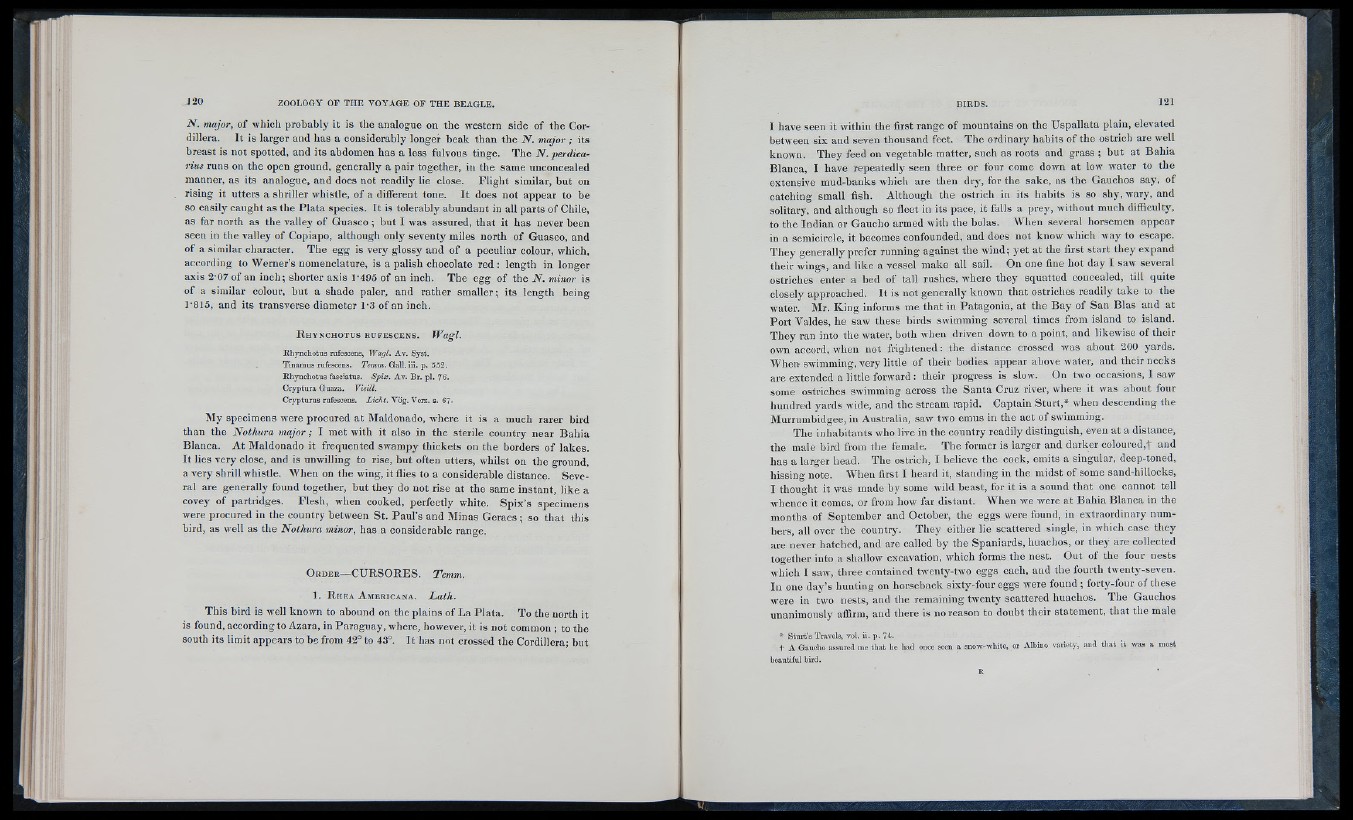
N . major, of which probably it is the analogue on the western side of the Cordillera.
It is larger and has a considerably longer beak than the N. major; its
breast is not spotted, and its abdomen has a less fulvous tinge. The N . perdica-
rius runs on the open ground, generally a pair together, in the same unconcealed
manner, as its analogue, and does not readily lie close. Flight similar, but on
rising it utters a shriller whistle, of a different tone. It does not appear to be
so easily caught as the Plata species. It is tolerably abundant in all parts of Chile,
as far north as the valley of Guasco ; but I was assured, that it has never been
seen in the valley of Copiapo, although only seventy miles north of Guasco, and
of a similar character. The egg is very glossy and of a peculiar colour, which,
according to Werner’s nomenclature, is a palish chocolate red : length in longer
axis 2*07 of an inch; shorter axis 1'495 of an inch. The egg of the N. minor is
of a similar colour, but a shade paler, and rather smaller; its length being
P815, and its transverse diameter 1-3 of an inch.
R h y n c h o t u s r u f e s c e n s . Wagl.
Rliynchotus rufescens, Wagl. Av. Syst.
Tinamus rufescens. Temm. Gall. iii. p. 552.
Rhjmchotus fasciatus. Spix. Av. Br. pl. 76.
Cryptura Guaza. Vieill.
Crypturus rufescens. Licht. Vog. Verz. s. 67-
My specimens were procured at Maldonado, where it is a much rarer bird
than the Nothura major; I met with it also in the sterile country near Bahia
Blanca. At Maldonado it frequented swampy thickets on the borders of lakes.
It lies very close, and is unwilling to rise, but often utters, whilst on the ground,
a very shrill whistle. When on the wing, it flies to a considerable distance. Several
are generally found together, but they do not rise at the same instant, like a
covey of partridges. Flesh, when cooked, perfectly white. Spix’s specimens
were procured in the country between St. Paul’s and Minas Geraes; so that this
bird, as well as the Nothura minor, has a considerable range.
O r d e r — CURSORES. Temm.
1 . R h e a A m e r ic a n a . Lath.
This bird is well known to abound on the plains of La Plata. To the north it
is found, according to Azara, in Paraguay, where, however, it is not common ; to the
south its limit appears to be from 42° to 43°. It has not crossed the Cordillera; but
I have seen it within the first range of mountains on the Uspallata plain, elevated
between six and seven thousand feet. The ordinary habits of the ostrich are well
known. They feed on vegetable matter, such as roots and grass ; but at Bahia
Blanca, I have repeatedly seen three or four come down at low water to the
extensive inud-hanks which are then dry, for the sake, as the Gauchos say, of
catching small fish. Although the ostrich in its habits is so shy, wary, and
solitary, and although so fleet in its pace, it falls a prey, without much difficulty,
to the Indian or Gaucho armed with the bolas. When several horsemen appear
in a semicircle, it becomes confounded, and does not know which way to escape.
They generally prefer running against the wind; yet at the first start they expand
their wings, and like a vessel make all sail. On one fine hot day I saw several
ostriches enter a bed of tall rushes, where they squatted concealed, till quite
closely approached. It is not generally known that ostriches readily take to the
water. Mr. King informs me that in Patagonia, at the Bay of San Bias and at
Port Valdes, he saw these birds swimming several times from island to island.
They ran into the water, both when driven down to a point, and likewise of their
own accord, w'hen not frightened: the distance crossed was about 200 yards.
When swimming, very little of their bodies appear above water, and their necks
are extended a little forward : their progress is slow. On two occasions, I saw
some ostriches swimming across the Santa Cruz river, where it ivas about four
hundred yards wide, and the stream rapid. Captain Sturt,* when descending the
Murrumhidgee, in Australia, saw two emus in the act of swimming.
The inhabitants who live in the country readily distinguish, even at a distance,
the male bird from the female. The former is larger and darker coloured,! and
has a larger head. The ostrich, I believe the cock, emits a singular, deep-toned,
hissing note. Wlien first I heard it, standing in the midst of some sand-liillocks,
I thought it was made by some wild beast, for it is a sound that one cannot tell
■»’hence it comes, or from liow far distant. When we were at Bahia Blanca in the
months of September and October, the eggs were found, in extraordinary numbers,
all over the country. They either lie scattered single, in which case they
are never hatched, and are called by the Spaniards, huachos, or they are collected
together into a shallow exc-avation, which forms tlie nest. Out of the four nests
which I saw, three contained tweiity-tw’o eggs each, and the fourth twenty-seven.
In one day’s hunting on horseback sixty-four eggs were found ; forty-four of these
were in two nests, and the remaining twenty scattered huachos. The Gauchos
unanimously affirm, and there is no reason to doubt their statement, that the male
* Sturt’s Travels, vol. ii. p. 74.
+ A Gaucho assured me that he had once seen a snow-white, (
beautiful bird.
K
■ Albino variety, and that it '«■as a most